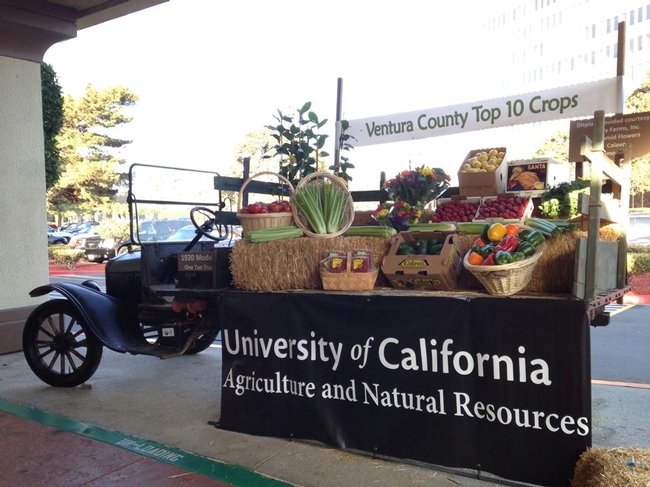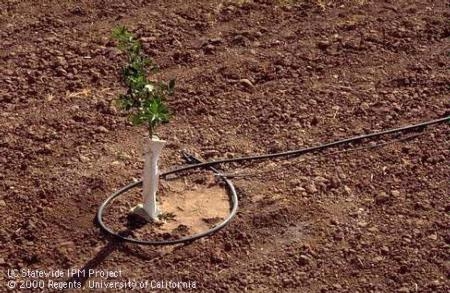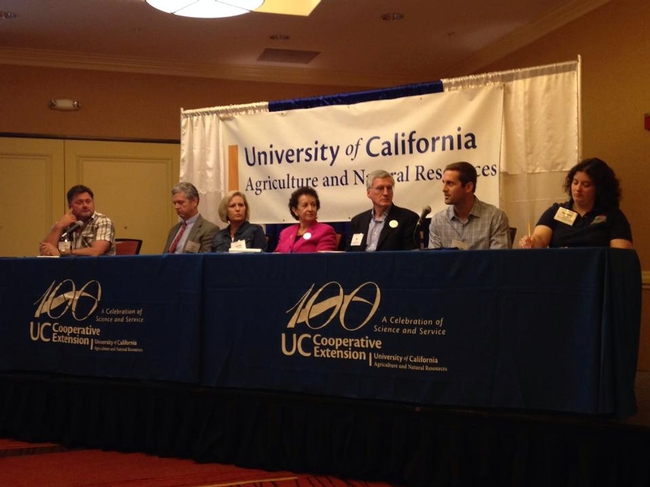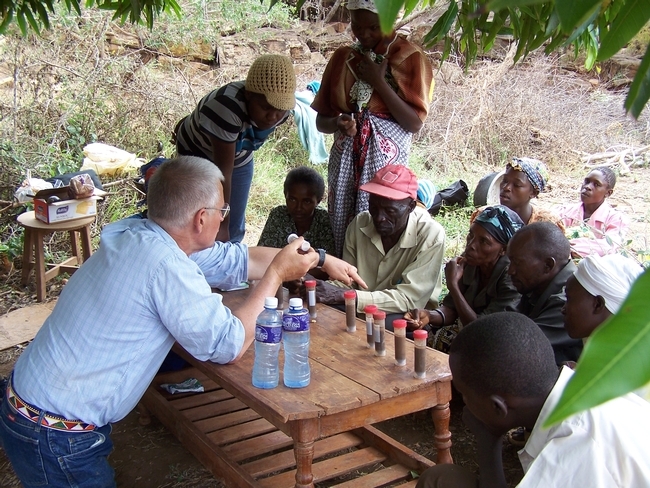Posts Tagged: Oleg Daugovish
Drought rekindles farmers' interest in drip irrigation
Drip irrigation isn't a new technology, but the drought in California is giving farmers greater incentive to consider installing the proven water-conserving irrigation technique, reported the Merced Sun-Star.
The use of plastic emitters in drip irrigation began in 1956 on a Kibbutz in Israel, where, like California, water demand is perennially greater than supply. Drip was introduced into the United States in the early 1960s.
Sun-Star reporter Marina Gaytan spoke to Scott Stoddard, UC Cooperative Extension advisor in Merced County, to get his thoughts about the trend toward drip.
“You can get water savings by using drip, but often times what you're really getting is improved water use efficiency,” Stoddard said. “You've improved your yield for the same amount of water.”
According to a farmer quoted in the story, installing a one-year surface drip system costs about $400 per acre. Some farmers are installing buried drip irrigation, which runs about $1,500 per acre but will last for many years.
Farmers welcome recent rainfall
Ventura County Star
Even though springtime rainfall can cause molds to grow in strawberries, and splashing raindrops can spread fungal and bacterial pathogens, farmers are delighted with the wet weather.
"We're going to lose some fruit, but that's a small price to pay," said Oleg Daugovish, UCCE advisor in Ventura County.
Before the rain began to fall, Daugovish advised growers to apply protective fungicides and open up plant canopies to expose the inside of the plants.
Many agricultural issues can be resolved with UC Cooperative Extension
There are many issues facing Ventura County farmers that UC Cooperative Extension is working to resolve, according to presentations yesterday at an event celebrating UCCE's first 100 years of science and service. The event was covered by reporter Carol Lawrence of the Ventura County Star.
At the event, UCCE advisors talked about the status of ag industry in Ventura County, where total farm production is nearly $2 billion annually. Strawberries, the county's leading crop since the early 2000s, are valued at $690 million. However, production is threatened by dwindling water supplies.
"We can't avoid this topic," said Oleg Daugovish, UCCE advisor.
UCCE advisor Ben Faber also discussed the water situation. The average annual rainfall in Oxnard was 17 inches between 2003 and 2008.
"We're living in an environment that rarely sees the average rainfall," Faber said.
Faber's work includes showing growers how using too much or too little water is more likely to cause plant disease and demonstrating new ways of measuring the water content in soil, the article said. One solution to water woes is using recycled water in nurseries. The practice saves 14 to 42 percent of water.
UCCE advisor Jim Downer talked about the movement of exotic pests that are a potential challenge to agriculture. California is particularly vulnerable to these pests because of its vast and varying geography and climate, he said.

Ventura County's top 10 ag commodities were on dispaly in a Model T truck at the UC Cooperative Extension Celebration of Science and Service.
UC researchers share knowledge in Kenya’s Kitui District
In June of this year, three University of California scientists went to the Kitui District of Kenya on a USAID mission.
Food and water scarcity are simply a part of life for most in this region. Since 1992 the Sahelian Solution Foundation (SASOL) has been constructing dams and working with Kitui communities to address water scarcity and issues of community development and agricultural production.
Agricultural production in Kenya is full of challenges. Water is carried by hand from wells or dams for household and agricultural needs. Previous to this mission, crops were watered inefficiently by flooding small basins. Nitrogen tests in some locations revealed levels at which most vegetable crops would be nitrogen deficient. Some of the villages have no road access.
UC’s Steve Fennimore, Jeff Mitchell, and Oleg Daugovish went to help SASOL and the people they serve make better use of their resources.
They met with village leaders and SASOL personnel in Kitui. Here they provided training and demonstrations covering topics including:
- Demonstrations of gravity-flow drip irrigation systems from water tanks to individual beds with irrigation lines
- Discussed use of mulches on soil to minimize evaporation and enhance soil conservation
- Solarization, nursery for transplants, diseases and insects, training tomato plants and culture
- Soil types, determination of soil moisture, quick nitrogen test, use of cover crops and mulches
- Water quality (pH, hardness, salts), organic fertilizers, collection and use of urine as a rapidly available nitrogen source.
Later the information was shared in the Maito village, where onions, green kale and green grams (Phasleolus aureus) are grown. The next day found the group in the Kituvwi village, where due to poor crop production, meals are currently limited to once a day. The following day was spent in the Kathayoni village. Farmers in the Kathayoni village grow kale, onions and tomatoes.
SASOL will continue the training for members in villages not reached during this visit.
The majority of farmers in the Kitui District are women. Information was well received in all locations and many questions were asked. At each village the scientists were fed a stew of corn and beans, supplemented by avocado slices or bread, with tea and milk to drink.
The last day time was spent at the South East University College. Potential for agricultural experimentation and greenhouses was discussed, and UC scientists gave a seminar about UCCE function and on anaerobic soil-borne pest control.
Alternatives to fumigation and improving fumigant efficacy
Synthetic soil fumigants such as chloropicrin and 1,3-D are used by some commercial growers to control soilborne pathogens, weeds and nematodes prior to planting strawberries, onions, tomatoes, eggplant, peppers and spinach.
These fumigants and all other biocidal products with the potential to harm the environment and human health are highly regulated by the federal Environmental Protection Agency, the state Department of Pesticide Regulation, and county agricultural commissioner's offices.
UC Cooperative Extension farm advisor Oleg Daugovish and his collaborators work hard to find effective, environmentally safe and economically viable ways to improve efficacy of fumigants and to investigate alternatives to soil fumigation. The Ventura County Cooperative Extension website has archived audio and visual presentations, which include the following topics:
- Assessment of permeability of commercial tarps under a variety of cultural practices and in various soil and environmental conditions is expected to lead to better understanding of maximizing fumigant effectiveness while reducing emissions.
- Growing in substrate (soil-less culture) allows growers to produce crops with minimal plant disease and weeds without using fumigants.
- Heating soil using steam is a successful way to disinfest it. However, the process to generate steam in a field can be slow and very expensive. Researchers are working to find ways to improve speed while reducing cost.
- Most organisms, including plant pathogens, cannot survive without oxygen. Researchers are investigating an organic method to create anaerobic (oxygen-free) conditions to treat soil before planting.
- Planting mustard as a cover crop can provide many positive benefits, one of which is allelochemical compounds. These compounds found in mustard are similar to those found in fumigants. Current research shows it is possible to use this green biomass to prepare fields for production.
To read more about Daugovish's research, visit http://ceventura.ucdavis.edu/Com_Ag/comveg.
Ventura celebrates strawberries
Leading up to the California Strawberry Festival, to be held this weekend at Strawberry Meadows at College Park in Oxnard, the Ventura County Star championed the fruit's contribution to the local economy in an article published yesterday.
In 2009, strawberries contributed $515.4 million to the county's $1.6 billion of total agricultural revenues, the story said. That was up 31 percent from $393.5 million in 2008.
Ventura County agricultural commissioner Henry Gonzales said the next crop report will show growers added another 100 acres of strawberries in 2010.
"It's a good thing," Gonzales was quoted. "It says to me there's still room for growth in the production side because there's growth on the market side."
Reporter Stephanie Hoops contacted UC Cooperative Extension strawberry advisor Oleg Daugovish to get his take on the current strawberry season.
The article said Daugovish described the season as "decent."
Meanwhile, strawberry growers are feeling pressure from a controversy over a new soil fumigant, methyl iodide, which the Department of Pesticide Regulation approved in December.
"Concern about the ability to use it is great," Daugovish was quoted.
In March, Gov. Brown said he plans to take "a fresh look" at the DPR decision. Environmental and farmworker groups are opposed to methyl iodide use in agriculture, but DPR approved the pesticide's use under strict safety measures, including buffer zones and site-specific permits from local agricultural commissioners.

Strawberries make a significant contribution to the Ventura County economy.





